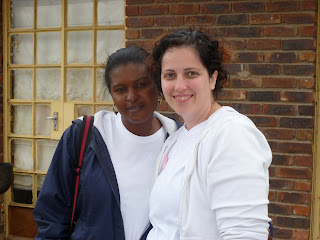"It doesn't pay," says Gladys, "but it's important work...It's my people…It's my community!" We are walking dirt roads visiting bed-ridden patients in Huntington. Hospice work is one of the services coordinated by Swa Vana. Sixteen hospice workers spread out over the village every day to take care of people too sick or weak to care for themselves.
We enter the first house. Its small and the thin mattress in the middle of the floor dominates the room. Gladys moves around opening the two windows, sweeping the floor, and piling up the scant laundry. The patient sits up. She is one of the lucky ones I'm told. She can scoot around on her hands, so she can move herself out to the doorstep for fresh air. I look around at the bare cinderblock walls, the small wooden bench along the back wall with a few belongings stacked on it.
Gladys talks to her patient, learning that she did eat that morning. She is gentle and kind, tying a fresh hankerchief around her head. It’s a chilly day, grey and overcast. None of the patients we visit want baths that day. It's too cold. We visited three patients total. Watching the hospice workers in action was amazing. Their empathy for their patients is real. Their commitment to their community is evident. They do not earn money doing this work. Swa Vana does not have funding in place to pay them. They are paid in food parcels.
Swa Vana was asked by the village elders to take on this project over a year ago. They have had some donations, but not nearly enough to meet the needs in the village. When we were there in September, they only had enough knappies (adult diapers) to last the month. We took some supplies over, and it was nice to know that instead of two thermometers for 16 workers, they now have one apiece. It's not nearly enough. Not that any of these people complain. They are so very grateful for everything that they do have. It is me, the missionary, looking at the situation with fresh, wide-eyed culture shock, who wants to wave the magic money wand and make it all better. It's a sobering reality: I can't just fix it. I can help alleviate the need by collecting and delivering supplies. I can care enough to pray. I show that I care by going back whenever I can, and doing whatever I can to help.
Huntington is where Swa Vana started six years ago, after bringing in supplies and establishing relationships in the village. As a result, the tribal leaders offered Swa Vana the Huntington village community center to establish a place where children in dire circumstances could be fed. The bats in the roof were evicted, the buildings were cleaned up and kitted out with kitchen supplies. There are hundreds of stories of ways that Swa Vana has effected change in this area -- stories of initial resistance, which turned into cooperation. Stories of salvation that occurred simply because Jesus showed up in the form of a white woman and her family and fed the hungry -- with no expectations of anything in return. Five years later, the tribal leaders again ask Charmaine to take on a project: Hospice care. Again, Swa Vana steps up, doing what they can do with limited resources.
A new Swa Vana bulding is going up in Huntington. The land was donated, the bricks are made, and the bulding can move forward as soon as the municipality provides the grader needed to level the ground. We walk over to the property and Charmaine describes what it will look like. She points out where the kitchen will be, how the building will be set up. She wants to build hospice rooms for the terminally ill patients, and establish a computer training center for the villagers. This is an ambitious vision. The effort truly does take a community. I see this project growing as more and more of the community gets on board. I see change coming, slowly but surely. Children who have grown up being fed by Swa Vana are graduating school and either obtaining work or establishing their own enterprises. I see a people working together to overcome some pretty overwhelming odds. I want to be a part of it. How 'bout you?
Gladys and I. She has healing hands.

awesome post G!
ReplyDelete